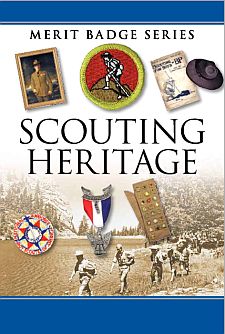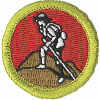- Discuss with your counselor the life and times of Lord Baden-Powell of Gilwell. Explain why he felt a program like Scouting would be good for the young men of his day. Include in your discussion how Scouting was introduced in the United States, and the origins of Boy Scouting and Cub Scouting under Baden-Powell.
- Do the following:
- Give a short biographical summary of any TWO of the following,
and tell of their roles in how Scouting developed and grew in the
United States.
- Daniel Carter Beard
- William D. Boyce
- Waite Phillips
- Ernest Thompson Seton
- James E. West
- "Green Bar Bill" Hillcourt
- Discuss the significance to Scouting of any TWO of the following:
- Brownsea Island
- The First World Scout Jamboree
- Scouts BSA Handbook
- Scout Life magazine (formerly Boy's Life)
- Give a short biographical summary of any TWO of the following,
and tell of their roles in how Scouting developed and grew in the
United States.
- Discuss with your counselor how Scouting's programs have developed over time and been adapted to fit different age groups and interests (Cub Scouting, Scouts BSA, Exploring, Venturing)
- Do ONE of the following:
- Attend either a BSA national jamboree, OR world Scout jamboree, OR a national BSA high-adventure base. While there, keep a journal documenting your day-to-day experiences. Upon your return, report to your counselor what you did, saw, and learned. You may include photos, brochures, and other documents in your report.
- Write or visit the National Scouting Museum. Obtain information about this facility. Give a short report on what you think the role of this museum is in the Scouting program.
- Visit an exhibit of Scouting memorabilia or a local museum with a Scouting history gallery, or (with your parent's permission and counselor's approval) visit with someone in your council who is recognized as a dedicated Scouting historian or memorabilia collector. Learn what you can about the history of the BSA. Give a short report to your counselor on what you saw and learned.
- Learn about the history of your unit or Scouting in your area. Interview at least two people (one from the past and one from the present) associated with your troop. These individuals could be adult unit leaders, Scouts, troop committee members, or representatives of your troop's chartered organization. Find out when your unit was originally chartered. Create a report of your findings on the history of your troop, and present it to your patrol or troop or at a court of honor, and then add it to the troop's library. This presentation could be in the form of an oral/written report, an exhibit, a scrapbook, or a computer presentation such as a slide show.
- Make a collection of some of your personal patches and other Scouting memorabilia. With their permission, you may include items borrowed from family members or friends who have been in Scouting in the past, or you may include photographs of these items. Show this collection to your counselor, and share what you have learned about items in the collection. (There is no requirement regarding how large or small this collection must be.)
- Reproduce the equipment for an old-time Scouting game such as those played at Brownsea Island. You may find one on your own (with your counselor's approval), or pick one from the Scouting Heritage merit badge pamphlet. Teach and play the game with other Scouts.
- Interview at least three people (different from those you interviewed for requirement 5) over the age of 40 who were Scouts. Find out about their Scouting experiences. Ask about the impact that Scouting has had on their lives. Share what you learned with your counselor.
NOTE: Scouts that wish to use Option b for completing Requirement 4, and choose to write the National Scouting Museum, must send a letter or e-mail to the address below. Here's the procedure:
- First, write a letter or email to the museum
- Scouts must include the following information: first and last name, current Scout rank and their mailing address.
- Then send the letter, with their parent's permission, either by
email to
philmont.museums@scouting.org (with "Scouting Heritage Merit Badge"
in the subject line) or via regular mail to:
- National Scouting Museum – Philmont
Scout Ranch
Attn: Scouting Heritage Merit Badge
17 Deer Run Road
Cimarron, NM 87714
- National Scouting Museum – Philmont
Scout Ranch
- Parents or leaders should verify that the Scout's information appears legible and is accurate; A number of letters every year are received where the Scout's information isn't legible or is inaccurate.
- Then, wait for a response.
- Scouts will receive:
- A letter, which will also answer any questions the Scout might have asked during the inquiry. The letter may feature the National Scouting Museum – Philmont Scout Ranch passport stamp and date.
- A museum facts sheet and timeline of the history of BSA museums
- A museum brochure
- IMPORTANT:
- Email/snail mail requests should be from Scouts, not merit badge counselors or parents
- Scouts should feel free to ask a question about BSA history, the museum itself or Philmont. The idea is to do more than merely write, "I'm working on Scouting Heritage merit badge, please send information."
- Don't use the National Scouting Museum Facebook page to make a request. Stick to email or snail mail.
- Counselors can verify that a Scout completed the requirement
by:
- A Scout's checking in to the museum's location on Facebook if they visit in person
- A dated "National Scouting Museum passport stamp," available in the lobby
- A mailed reply from the museum
- An emailed reply from the museum
- Completion of the museum's virtual geocache
- If Scouts write a letter, make sure it is legible - especially the return address.
- Remember that the visit, letter or email is the first step of requirement 4b. The second is to "give a short report on what you think the role of this museum is in the Scouting program."
- Scouts should allow at least three weeks for a response.
- Information will not be sent to counselors or Scoutmasters, only to Scouts working on the merit badge.
Scouts send in more than 1,000 letters every year (in 2013, that accounted for 28 percent of all Scouts who earned this MB), and while the museum staff strives to send information within three weeks, there are times when that is not possible.
BSA Advancement ID#:
143
Scoutbook ID#:
103
Requirements last updated in:
2024
Pamphlet Publication Number:
35970
Pamphlet Stock (SKU) Number:
Pamphlet Revision Date:
|
|||||||
Page updated on: February 08, 2024









